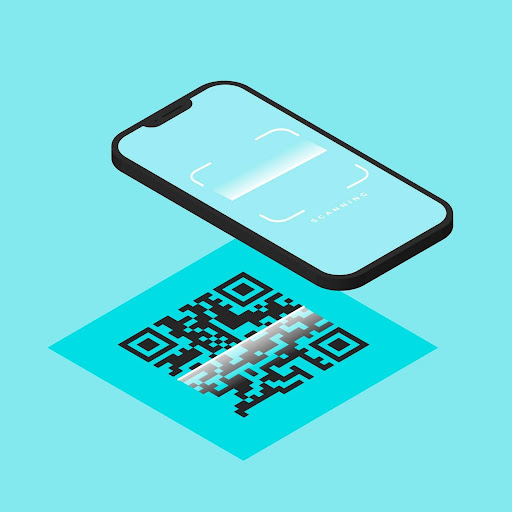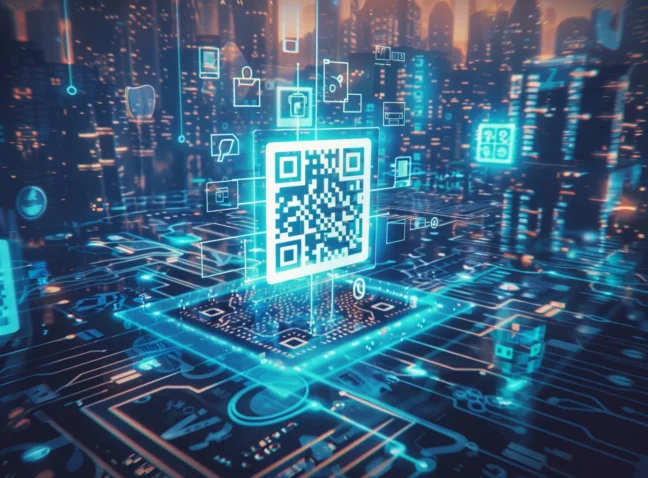You’ve likely seen Micro QR codes. Usually much smaller than QR codes, you’ve most likely seen them on things like business cards and product packaging. And you may have been left wondering: What’s the point in using a micro QR code over a normal one?
A very good question, and one that My QR Code is going to answer over the course of this guide. We’ll be going over what makes them different, why they’re used, and how to generate micro QR codes. Let’s dive in.
What is a Micro QR Code?
Micro QR codes are as the name suggests are small QR codes. Their appearance resembles a quarter of a normal QR code, often only containing one corner square (in comparison to three). Because of their small size, their storage capabilities are much more limited, so they aren’t suitable for larger files, URLs, or images.
Granted, they’re designed to store less information. That’s because they were made to be embedded on surfaces with limited space, like computer components for instance.

Technology Behind Micro QR Codes
The tech that powers micro QR codes comprises four major components: data modules, a finder pattern, a timing pattern, and a quiet zone.
Let’s explore each of these components in more detail:
Micro QR Code Data Modules
Data modules are black and white square dots arranged in a square grid pattern. Their combination makes up a micro QR code and allows for its scanning.

Data modules encode information as binary values. Black ones represent binary 1, while white modules stand for binary 0. Mixing these values into a unique pattern lets you embed numeric, alphanumeric, and other specific characters into a code.
Micro QR Code Finder Pattern
The finder or positioning patterns are central points of a QR code. They resemble larger black-and-white square modules, unlike the smaller dots that comprise the data modules. Positioned at the QR code’s edges, these patterns ensure scanners can correctly identify and read the QR code.
Since micro QR codes accommodate less data and are smaller than standard ones, they only need one finder pattern. Traditional QR codes leverage three in comparison. This pattern is typically placed at the upper-left corner of the micro QR code.
Micro QR Code Timing Pattern
The timing pattern consists of alternating black and white modules: one column on the left and one row on the top of the micro QR code. The intersection of these vertical and horizontal lines ensures the scanning device syncs correctly and swiftly determines the QR code’s size, symbol version, and density.
A standard QR code has multiple horizontal and vertical timing patterns. Micro QR codes, on the other hand, usually rely on a single timing pattern for horizontal and vertical synchronization.
Micro QR Code Quiet Zone
The quiet zone is an empty margin space around other micro QR code components. It creates a buffer between the code and its surrounding elements and makes it easy for scanning devices to identify the QR code’s boundaries.
A quiet zone border for traditional QR codes must be at least four modules wide. Micro QR codes, as more compact solutions, typically require a clear margin space of two modules.
Micro QR Code Error Correction Levels
Error correction is a Reed-Solomon algorithm-based process that lets scanning devices read poorly printed or damaged QR code data. This mechanism helps scanners reconstruct missing information and ensure accurate decoding.
Micro QR codes offer several levels of error correction. Read on to study them in greater depth.
Micro QR Code Versions of Error Correction
Micro QR codes support three error correction levels: L, M, and Q. Each of them corresponds to a different degree of recovery capacity. Let’s look at these levels more precisely:
- Level L (Low): Can restore up to 7% of encoded data.
- Level M (Medium): Can recover up to 15% of encoded data.
- Level Q (Quartile): Can restore up to 25% of encoded data.
Keep in mind that error correction levels take up space within the QR code itself. Considering that you’re already working with limited data storage with micro QR codes, you’ll need to decide whether you have the capacity to encode large error correction levels.
Micro QR Code Data Capacity
The micro QR code’s data capacity determines how much information can be encoded within this small 2D barcode. The amount of data you can embed depends on several factors.
First of all, the chosen character type affects the data capacity. Other factors are the selected error correction level (L, M, or Q) and the grid size.
Data Capacity for Various Character Sets
The micro QR code’s data capacity depends on the character type:
– **Numeric data: **Micro QR codes can accommodate up to 35 numeric characters.
– **Alphanumeric data: **Micro QR codes can store 20 to 25 letters and numeric digits.
– **Binary data: **Micro QR codes can encode around 15 bytes or 128 data bits.
That’s a smaller amount of data compared to traditional QR codes. Some standard codes can store over 7,000 numeric digits, 4,200 alphanumeric characters, and 2,900 bytes.
Micro QR Code Options
Micro QR codes come in four different size options. They are called M1, M2, M3, and M4 and correspond to varying grid dimensions. Let’s get each of them straight.
- M1: 11×11 modules.
- M2: 13×13 modules.
- M3: 15×15 modules.
- M4: 17×17 modules.
Compared to these minimalistic micro QR codes, the smallest standard scannable ones are from 21×21 modules in size and beyond.
Micro QR Code Standards
The core standards for Micro QR codes are ISO/IEC 18004, JIS X 0510, and AIM ISS QR Code. Let’s explore each in depth.
- ISO/IEC 18004: Defines the micro QR code’s specifications and specifies the encoding, decoding, and error correction procedures.
- JIS X 0510: Follows the ISO/IEC 18004 standard and ensures alignment of Japanese micro QR codes with international practices.
- AIM ISS QR Code: Focuses on information encoding rules for standard and micro QR codes.
An ISO/IEC 23941:2022 standard introduced in May 2022 concentrates specifically on rectangular micro QR codes or rMQR. It outlines the symbology specifications and data capture and identification techniques.
Micro QR Code Examples
Micro QR codes can take various forms and places, from product labels to circuit boards. It’s possible owing to their compact size and efficient data encoding features. Look at the following real-life examples of these codes:
- Product labels: Micro QR codes store serial numbers, manufacturing dates, or essential product details.
- Identification badges: Micro QR codes can contain employee details or access permissions in corporate settings.
- Circuit boards: Micro QR codes may be used on circuit boards for easier component tracking.
- Electrical items: Micro QR codes can be placed on electronic products and provide details on serial numbers or technical specs.
As you can see, it’s mostly on items where space is extremely limited, and where high data storage isn’t completely necessary.
Micro QR Code Size
The micro QR code’s size ranges from 11 x 11 to 17 x 17 modules. Or if you’d prefer, 1 x 1 cm or about 0.4 x 0.4 inches.
Generally, this is the best size for a micro QR code, as it’s specifically designed for smaller spaces. For larger sizes, you’d be better off generating a QR code, which has more data capacity and higher error correction levels if you’d prefer. 2 x 2 cm is often considered the best QR code size.
Scanning Micro QR Codes
Micro QR codes can be scanned through smartphones, tablets, dedicated <a href=”myqrcode.com/barcode-scanner“>barcode scanners, or any other smart device with a camera. If you’re trying to scan a micro QR code with a smartphone, you’ll notice the built-in scanner can’t read them.
Thankfully, there are plenty of dedicated scanning apps on the App Store and Google Play which are compatible with micro QR codes.
Generating Micro QR Codes
To create micro QR code, you can leverage online generators and software tools like My QR Code. Here’s a quick guide on how to generate it:
- Open a chosen micro QR code generator,
- Enter the necessary data (a URL, short text, contact info, etc.),
- Design your QR code’s pattern and quiet zone,
- Optionally customize color, size, and error correction level,
- Generate a micro QR code.
Once you create a micro QR code, print and review it to find out if its size and appearance suit your usage purposes. Besides that, check if your code is easily scannable and provides accurate information.
Benefits of Micro QR Codes
The main benefits of micro QR codes are small size and improved scanning efficiency. But there are more. Let’s review each of them in detail:
- Space efficiency: The micro QR code’s compact size allows you to print them even on the smallest surfaces.
- Faster scanning: Micro QR codes are easier to decode since they contain less data.
- High readability: Owing to error correction, micro QR codes can be read from any angle.
- Tailored error correction: Micro QR codes provide three flexible error correction levels.
Besides the above advantages, micro QR codes are well-suited for curved and non-flat surfaces. You can print them on objects of various shapes and be sure of their scannability.
Limitations and Challenges
The key limitation of micro QR codes is limited data capacity. While it’s a benefit for specific use cases like product labels, it’s a drawback for applications that deal with larger amounts of data, e.g., a QR code for restaurant menus.
Micro QR codes won’t suit complex data sets as well. If you want to encode images, videos, or PDF files, opting for standard QR codes is best. The latter are available in MyQRCode.
Let’s review several use cases and determine the optimal scenarios for leveraging micro QR codes vs. standard QR codes.
| QR Codes in Different Use Cases | |
| Use Case | QR Code Type |
| Restaurants | Standard QR code |
| Business cards | Micro QR code |
| Billboards | Standard QR code |
| Retail | Standard QR code |
| Logistics | Standard or micro QR code |
| Product labeling | Micro QR code |
Recapping the above points, using traditional QR codes for menu, billboards, retail, and other large-scale purposes is wise. Meanwhile, micro QR codes find their niche in smaller-scale applications.
Application Areas
Micro QR codes are widespread across different industries and find applications in logistics, B2B, healthcare, and beyond. Let’s see how exactly they are used.
- Logistics: Used to track packages, inventory items, and shipments.
- B2B: Employed in invoices and inventory management.
- Retail: Used in product labels, PoS transactions, and inventory management.
- Healthcare: Utilized on medication packaging, patient wristbands, and medical equipment.
- Manufacturing: Used for detail identification, serial number tracking, and technical specs sharing.
On top of that, micro QR codes can be used in event ticketing. Owing to their small size and quick scanning capabilities, they offer an enjoyable experience for event attendees.
Compatibility of Micro QR Codes for iOS and Android Devices
Smart iOS and Android devices are generally compatible with micro QR codes. However, their built-in features do not cover the ability to scan such codes. That’s why you’ll need a specialized reader or QR code maker for iOS and Android apps.
QR scanner applications are available on both the App Store and Google Play Store. You can choose those tools that support micro QR codes to decode the necessary information.
Main Differences Between a Micro QR Code and Other QR Code Types
The micro QR codes differ from other types of QR codes in size and data capacity. See the comparison in the table below:
| QR Codes in Different Use Cases | |
| Use Case | QR Code Type |
| Restaurants | Standard QR code |
| Business cards | Micro QR code |
| Billboards | Standard QR code |
| Retail | Standard QR code |
| Logistics | Standard or micro QR code |
| Product labeling | Micro QR code |
Compared to all other types of QR codes, micro QR codes are the smallest and can accommodate a lower amount of data. But these peculiarities are what make them stand out as valuable tools for specific applications with spatial constraints and demand for efficient data encoding.
Wrapping Up
All in all, micro QR codes aren’t common, but they can still be seen in various places like computer chips and product tags. They don’t have large storage capabilities, especially in comparison to QR codes, but considering they store data like tech specs and simple product codes, they don’t really need to.
The use cases of micro QR codes are very niche, and if you’d need a larger data capacity, it would be better to opt for a standard QR code.
And if you’re looking to generate your own QR code, you’re in the right place! At My QR Code, you can generate QR codes to fit any size, and for any need. You can generate QR codes for vCards, URLs, business pages, and more. And you’ve got plenty of design options to choose from, allowing you to change the QR code color, add borders and CTAs, and even upload your own personalized logo.
So what are you waiting for? Generate your QR code today!





